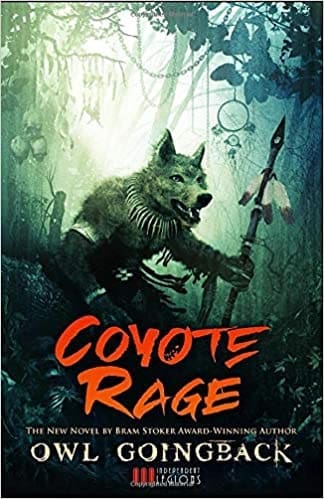Epeolatry Book Review: Coyote Rage by Owl Goingback

Disclosure:
Our reviews may contain affiliate links. If you purchase something through the links in this article we may receive a small commission or referral fee. This happens without any additional cost to you.

Title: Coyote Rage
Author: Owl Goingback
Genre: Horror
Publisher: Independent Legions Publishing
Release Date: 9th Feb, 2019
Synopsis:2019 BRAM STOKER AWARDS WINNER Bram Stoker Award-Winning author Owl Goingback makes a triumphant return to horror and fantasy in this gripping new novel. Coyote is on a murderous hunt, leaving behind a trail of carnage. The shape-shifter is determined to kill the human representatives to the Great Council in Galun’lati, eliminating the rule of mankind in the New World. But Raven has overheard the Trickster’s evil plan, and will do anything to protect Luther Watie and his daughter, Sarah Reynolds, even if it means turning his skin inside out. The forces of evil are aligning in two very different worlds. Can mankind be saved, or will creatures of fur and fangs once again reign supreme?
Synopsis: In this Bram Stoker award-winning novel, the spirit realm of Galun’lati is preparing for its next meeting of the Great Council with emissaries from each of the Animal tribes. A plot to eliminate the human emissary is underway. Bloodthirsty Coyote wants nothing more then to rid the Earth of humanity so that the animal can once again rise up and lay claim over the New World.
I was excited to read Coyote Rage as soon as it was announced that it had won the 2019 Bram Stoker award for Best Novel. Author Owl Goingback also won the Bram Stoker award for best First Novel for his 1996 novel, Crota. All of his novels and short stories within the genre have incorporated his Native American heritage, which certainly piqued my interest. With this most recent book, the first of a promised trilogy, Goinback focused on shapeshifters, and the relationship between their spirit domain and our own reality.
The story begins at the seat of high fantasy, and we are immediately introduced to the land of Galun’lati, the spirit world of the Cherokee. Galun’lati is home to all manner of fantastical creatures, as we will eventually discover, but also serves at the meeting place for the avatars of each of the major animal tribes, the Coyote being chief among them.
Coyote is both a trickster and a bloodthirsty psychopath, convincing the other animals that the only sensible move is to betray and murder the human avatar, Luther Waite, an aging Cherokee and member of the Great Council, so that the New World will again be theirs. It is only the Raven that stands up to Coyote, and makes it his mission to protect Luther and by extension, the human race.
Once in the New World, both the Coyote and Raven shapeshift into humans so that they can move among them undetected. I particularly enjoyed these descriptions of the animals transforming into humans. Shapeshifting is no easy business, but is instead written as an incredibly painful process that Goingback describes quite viscerally, such as when Raven first transforms:
“…he used his sharp beak to tug at the feathers covering his chest. He pulled several loose, and then plunged his beak deep into the bare spot he had created, causing his flesh to magically separate and his cloak of black feathers to fall away… he turned his skin inside out and slipped it back on… his bones popped and lengthened as they realigned themselves, the skin stretching tight and sealing itself over the new body.”
These moments brought to mind the painful werewolf transformation sequence from An American Werewolf in London. However, the strongest cultural reference point I found with the book was the Terminator films, believe it or not. Goingback brings together two beings from another place taking on human guise; one is sent to kill, one is sent to protect. When the Raven first shapeshifts in our reality, he appears as a muscular, naked man, and coincidentally find himself near a biker bar. His first priority is to steal clothes and a motorcycle. Pretty on the nose, but rather than seeming contrived, I enjoyed the mixture of science fiction pop culture with Native American mythology. It felt par for the course, with what Goingback was trying to accomplish tonally.
Despite its good writing and pacing, I found minimal horror aspects. Beyond one jarringly gory sequence in an elder-care home where Coyote viciously slaughters both the residents and the staff, this read more like a supernatural adventure story.
In retrospect, it might have been a mistake to begin the novel in Galun’lati, outlining the goals and objectives of our supernatural shapeshifters at the onset. I would have preferred more mystery. It’s hard for me to consider a story scary if there are no unknowns. It might have made for a more visceral experience had we begun from the POV of the human characters who have no idea why bloodthirsty coyotes are suddenly attacking them, and then figure that out along with them, with the revelation of the spirit realm serving as a climax, and not as a prologue.
Still, I’m interested to see how Goingback will continue the story and deepen the worldbuilding mythology with the next books in the series. Anyone who appreciates a unique voice in the world of horror should definitely check it out!
3/5
Available from amazon.










